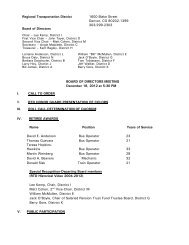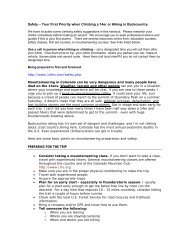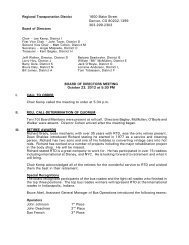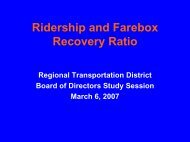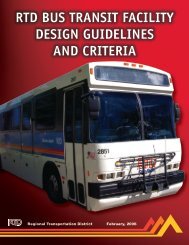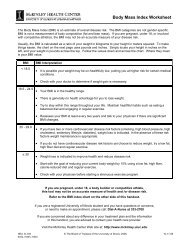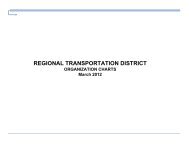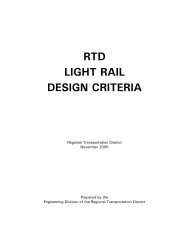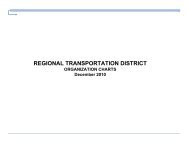Commuter Rail AC Electrification Load-Flow Simulation Report - RTD
Commuter Rail AC Electrification Load-Flow Simulation Report - RTD
Commuter Rail AC Electrification Load-Flow Simulation Report - RTD
Create successful ePaper yourself
Turn your PDF publications into a flip-book with our unique Google optimized e-Paper software.
<strong>Commuter</strong> <strong>Rail</strong> <strong>AC</strong> <strong>Electrification</strong> <strong>Load</strong>-<strong>Flow</strong> <strong>Simulation</strong> <strong>Report</strong> Revision 1<br />
Table 2 -<br />
2x25 kV Autotransformer-Fed System Voltages<br />
System Location Voltage (kV) Voltage (p. u.)<br />
Traction Power Substation Input Voltage 115.0 1.00<br />
Traction Power Substation Normal<br />
Upper Output Voltage Limit Catenary-to-<strong>Rail</strong>s 27.5 1.10<br />
Feeder-to-Catenary 55.0 1.10<br />
Traction<br />
Power<br />
Traction Power Substation No- Feeder-to-Catenary 53.0 1.06<br />
Supply<br />
<strong>Load</strong> Output Voltage<br />
Catenary-to-<strong>Rail</strong>s 26.5 1.06<br />
System<br />
Traction Power Substation Nominal<br />
Feeder-to-Catenary 50.0 1.00<br />
Output Voltage<br />
Catenary-to-<strong>Rail</strong>s 25.0 1.00<br />
Traction Normal Lower Voltage Limit for Catenary-to-<strong>Rail</strong>s 20.0 0.80<br />
Power All Systems in Service<br />
Distribution<br />
Sys-<br />
Emergency Minimum Operating<br />
Voltage for Outage Conditions<br />
tem<br />
Catenary-to-<strong>Rail</strong>s 17.5 0.70<br />
5.1.3 Use of the Voltages for the Study<br />
The nominal traction power supply system voltages were used in the computer simulations and<br />
the distribution system voltages along the various lines were calculated and compared to the<br />
values presented in the above table.<br />
The Normal Lower Voltage Limit was used as criterion in evaluation of the simulated system<br />
performance. For computer runs simulating the all equipment in-service condition (i.e. all<br />
substations, switching stations, paralleling stations, traction power transformers, feeders, and<br />
autotransformers in-service), the lowest train voltage along any of the three corridors during<br />
rush-hour operation should not fall below the Normal Lower Voltage Limit.<br />
Under system outage conditions, the lowest train voltage along any of the three corridors during<br />
rush-hour operation should not fall below the Emergency Minimum Operating Voltage for<br />
Outage Conditions.<br />
5.2 CONDUCTOR CURRENTS<br />
The highest currents in the distribution system conductors occur in the catenary and feeder<br />
conductors adjacent to the traction power substations. In order to evaluate the suitability of the<br />
conductors used in the study, the calculated load current root-mean-square (RMS) values were<br />
compared with the estimated ampacities of the distribution system conductors.<br />
The distribution system conductors considered for the Denver <strong>RTD</strong> commuter system in this<br />
study are shown in Table 3.<br />
Table 3 -<br />
Ampacity of the Traction Power Distribution System<br />
Conductor<br />
Number of<br />
Conductors<br />
per Track<br />
Size (kcmil<br />
or A.W.G.)<br />
Material<br />
Approximate<br />
Ampacity<br />
(A)<br />
Total<br />
Approximate<br />
Ampacity (A)<br />
Feeder Wire 1 556.5 <strong>AC</strong>SR 730 730<br />
Messenger Wire 1 4/0 H. D. Copper 480<br />
870<br />
Contact Wire 1 4/0 H. D. Copper 390<br />
02/27/2009 FRSC Page 17 of 250




